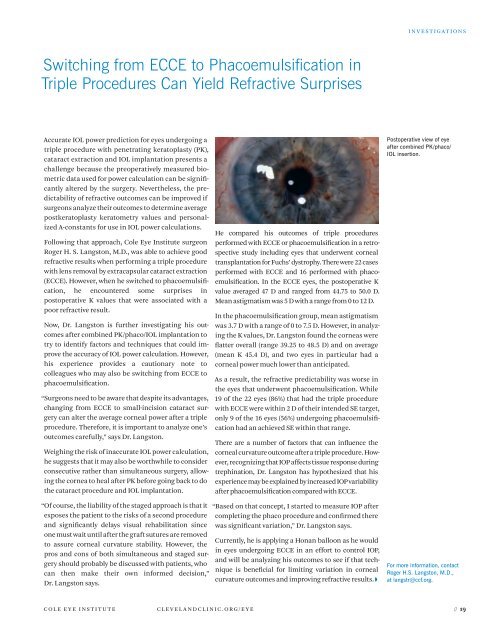Ophthalmology Update - Cleveland Clinic
Ophthalmology Update - Cleveland Clinic
Ophthalmology Update - Cleveland Clinic
You also want an ePaper? Increase the reach of your titles
YUMPU automatically turns print PDFs into web optimized ePapers that Google loves.
Switching from ECCE to Phacoemulsification in<br />
Triple Procedures Can Yield Refractive Surprises<br />
accurate iOl power prediction for eyes undergoing a<br />
triple procedure with penetrating keratoplasty (pK),<br />
cataract extraction and iOl implantation presents a<br />
challenge because the preoperatively measured biometric<br />
data used for power calculation can be significantly<br />
altered by the surgery. nevertheless, the predictability<br />
of refractive outcomes can be improved if<br />
surgeons analyze their outcomes to determine average<br />
postkeratoplasty keratometry values and personalized<br />
a-constants for use in iOl power calculations.<br />
Following that approach, cole eye institute surgeon<br />
roger h. s. langston, m.d., was able to achieve good<br />
refractive results when performing a triple procedure<br />
with lens removal by extracapsular cataract extraction<br />
(ecce). however, when he switched to phacoemulsification,<br />
he encountered some surprises in<br />
postoperative K values that were associated with a<br />
poor refractive result.<br />
now, dr. langston is further investigating his outcomes<br />
after combined pK/phaco/iOl implantation to<br />
try to identify factors and techniques that could improve<br />
the accuracy of iOl power calculation. however,<br />
his experience provides a cautionary note to<br />
colleagues who may also be switching from ecce to<br />
phacoemulsification.<br />
“surgeons need to be aware that despite its advantages,<br />
changing from ecce to small-incision cataract surgery<br />
can alter the average corneal power after a triple<br />
procedure. therefore, it is important to analyze one’s<br />
outcomes carefully,” says dr. langston.<br />
Weighing the risk of inaccurate iOl power calculation,<br />
he suggests that it may also be worthwhile to consider<br />
consecutive rather than simultaneous surgery, allowing<br />
the cornea to heal after pK before going back to do<br />
the cataract procedure and iOl implantation.<br />
“Of course, the liability of the staged approach is that it<br />
exposes the patient to the risks of a second procedure<br />
and significantly delays visual rehabilitation since<br />
one must wait until after the graft sutures are removed<br />
to assure corneal curvature stability. however, the<br />
pros and cons of both simultaneous and staged surgery<br />
should probably be discussed with patients, who<br />
can then make their own informed decision,”<br />
dr. langston says.<br />
he compared his outcomes of triple procedures<br />
performed with ecce or phacoemulsification in a retrospective<br />
study including eyes that underwent corneal<br />
transplantation for Fuchs’ dystrophy. there were 22 cases<br />
performed with ecce and 16 performed with phacoemulsification.<br />
in the ecce eyes, the postoperative K<br />
value averaged 47 d and ranged from 44.75 to 50.0 d.<br />
mean astigmatism was 5 d with a range from 0 to 12 d.<br />
in the phacoemulsification group, mean astigmatism<br />
was 3.7 d with a range of 0 to 7.5 d. however, in analyzing<br />
the K values, dr. langston found the corneas were<br />
flatter overall (range 39.25 to 48.5 d) and on average<br />
(mean K 45.4 d), and two eyes in particular had a<br />
corneal power much lower than anticipated.<br />
as a result, the refractive predictability was worse in<br />
the eyes that underwent phacoemulsification. While<br />
19 of the 22 eyes (86%) that had the triple procedure<br />
with ecce were within 2 d of their intended se target,<br />
only 9 of the 16 eyes (56%) undergoing phacoemulsification<br />
had an achieved se within that range.<br />
there are a number of factors that can influence the<br />
corneal curvature outcome after a triple procedure. however,<br />
recognizing that iOp affects tissue response during<br />
trephination, dr. langston has hypothesized that his<br />
experience may be explained by increased iOp variability<br />
after phacoemulsification compared with ecce.<br />
“Based on that concept, i started to measure iOp after<br />
completing the phaco procedure and confirmed there<br />
was significant variation,” dr. langston says.<br />
currently, he is applying a honan balloon as he would<br />
in eyes undergoing ecce in an effort to control iOp,<br />
and will be analyzing his outcomes to see if that technique<br />
is beneficial for limiting variation in corneal<br />
curvature outcomes and improving refractive results.<br />
i n v e s t i g a t i O n s<br />
Postoperative view of eye<br />
after combined PK/phaco/<br />
IOL insertion.<br />
For more information, contact<br />
Roger H.S. Langston, M.D.,<br />
at langstr@ccf.org.<br />
c O l e e y e i n s t i t U t e c l e v e l a n d c l i n i c . O r g / e y e //
















